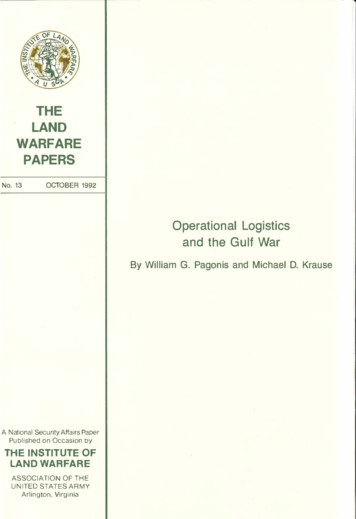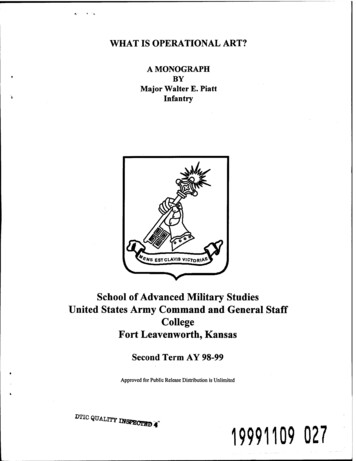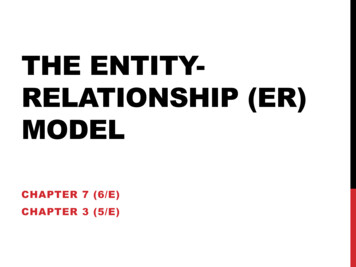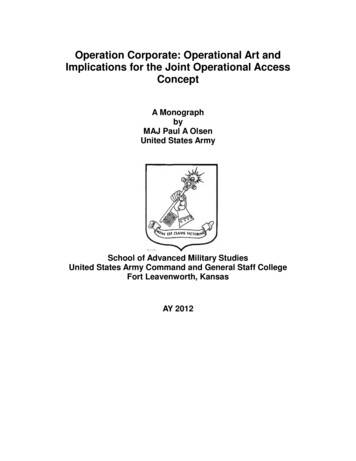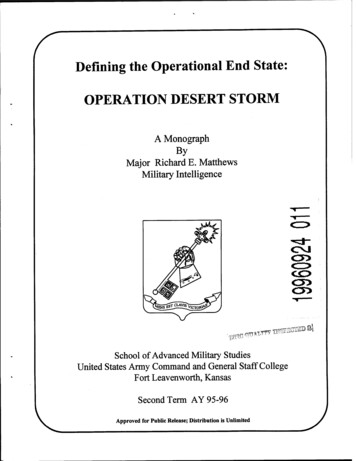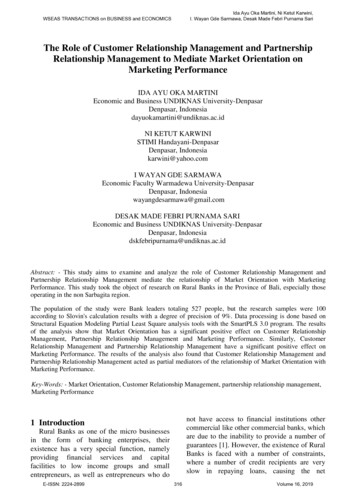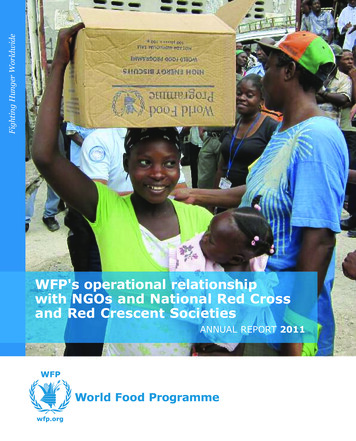
Transcription
Fighting Hunger WorldwideWFP's operational relationshipwith NGOs and National Red Crossand Red Crescent SocietiesAnnuAl RepoRt 2011
WFp'soperationalrelationshipwith nGosnationalRed Cross andRed CrescentandSocietiesAnnuAl RepoRt 2011
table of ContentsIntroduction by the executive DirectorFacts and Figures56Partnerships with NGOs in EmergenciesHaitinigerpakistan7778Collaboration with NGOsInternational nGo partnersnGo partners by RegionnGo partners by CountryWFp’s Main nGo partnersComplementary partnerships with nGosSectors of Collaboration with nGosServices provided by nGosprogramme Categories9910111112121516Food DistributionsDistributions by RegionDistributions by CountryDistributions by nGo16171718Collaboration with National Red Cross and Red Crescent Societies20Successful Partnership Story from the FieldWFp and Save the Children partner in nepal to Build Critical School Infrastructure2121Glossary of termsAcronyms used in this Documentphoto Credits222324the 2011 Annual Report on WFp's operational relationship with nGos uses data, photos andstories from the previous year to chronicle WFp’s operations during calendar year 2010.For a complete list of WFp’s international and local nGo partners seethe WFp website wfp.org:About Partners NGOs Annual WFP-NGO Reports Annexes 2011or contact the WFp nGo unit at WFP.NGOUnit@wfp.orgAnnual Report 20113
Introduction2010 was a challenging year for the World Food programme, with 263 million peopleaffected by natural disasters – 110 million more than in 2004, the year of one of themost destructive tsunamis in history. From the earthquake in Haiti to the drought inniger and the flooding in pakistan, WFp and its non-governmental organization (nGo)partners were called on to save lives and help rebuild livelihoods. these record-levelchallenges could only be met through proven and successful partnerships with WFpworking with its nGo cooperating partners.Beyond the heroic work of WFp and nGo staff responding to such emergencies,together we have helped communities and nations become more resilient and foodsecure. WFp assistance was deployed with more targeted and innovative tools thanever before, including purchase for progress (p4p), cash and vouchers, andenhanced nutritional products. the 1,997 nGos and community-based organizations(CBos) as well as the 34 national Red Cross and Red Crescent Societies that WFppartnered were a vital part of this success. In 2010, half of WFp’s global food aid,representing close to 2.2 million mt, was distributed by nGos.As the world changes, WFp and its partners are changing to meet new challengesand implement new tools, programmes and solutions. In scaling up our innovativetools, WFp will continue to rely on the experience, knowledge and reach of nGos. In2010, 88 percent of our country offices – 66 out of 75 – had partnerships with nGos.In nearly half of these offices WFp was collaborating with more than 20 nGo partners,leveraging the expertise of international nGos such as World Vision, Save theChildren and the Cooperative for Assistance and Relief everywhere (CARe), and theestablished community-level networks of hundreds of local nGos.From working on the front lines in Afghanistan and Somalia – some of the most difficultand dangerous places in the world – to the school feeding lines in Bolivia andCambodia, bringing hope to millions of children, WFp’s partnerships with nGos andnational Red Cross and Red Crescent Societies have transformed lives. together wewill continue to address the challenges and opportunities for reaching the mostvulnerable and hungry people.Josette Sheeranexecutive Director, World Food programmeAnnual Report 20115
Facts and FiguresNGO partners:1,997 NGOs/CBOs:1205 international1,792 localCountry offices with NGO collaboration:66 (out of 75)Projects with NGO collaboration:162 (out of 224)2Region with most NGO partners:latin America and the Caribbean (613 nGos)Countries with most NGO partners:Colombia (391 nGos)Somalia (181 nGos)the Sudan (155 nGos)Countries with 20or more NGO partners:28, or 42 percent of country offices withnGo collaborationMain NGO partnersby number of countries with WFPcollaboration:World Vision International (WVI) (33 countries)Save the Children International (30 countries)CARe International (17 countries)NGOs collaborating with WFPin five or more countries:27, or 13 percent of the international nGo partnersTotal food handed over to NGOs:2.2 million mt, or 50 percent of WFp's globalfood aidMain NGO partnersby volume of collaboration:WVI (193,464 mt)CARe International (108,917 mt)Main type of partnership:Cooperating partner (1,905 nGos, or 95 percentof all nGo partners)Main programme category ofcollaboration:protracted relief and recoveryoperations (pRRos) (1,235 nGos)Main sectors of collaboration:General food distribution (GFD) (503 nGos)Mother-and-child health and nutrition (MCHn) (354 nGos)Food for training (FFt) (330 nGos)Main NGO partnersand variety of collaboration:Catholic Relief Services (CRS) (19 sectors)WVI (19 sectors)Save the Children International (18 sectors)Main service provided:Food distribution (1,846 nGos)National Red Cross andRed Crescent (RC/RC) partners:34 national Societies:4 international30 localSee definitions of nGos andCBos in the Glossary of termsat the end of this report.12 the total number of projectsincludes all projects with fooddistribution carried out in 2010.projects are considered at thelowest level – the activity levelfor country programmes, andthe country level for regionalprojects. Special operationsare excluded.6WFp’s operational relationship with nGos and national Red Cross and Red Crescent Societies
Partnerships with NGOs in EmergenciesIn 2010, the world faced numerous large-scale emergencies that requiredextraordinary efforts from the humanitarian community, particularly the earthquake inHaiti, a hunger crisis in niger and unprecedented floods in pakistan. WFp could nothave dealt with these emergencies effectively without the collaboration of hundredsof local and international nGos and CBos.HaitiIn 2010, WFp worked with a range of partners in a major emergency response afterthe earthquake. WFp selected its main partners to cover food assistance andhurricane contingency planning, based on their capacity, experience and regionalpresence. As the food cluster lead, WFp fostered partnerships between its mainpartners and smaller/local nGos, and increased the coverage of food assistance bychannelling food requests through its main partners and their networks ofsmaller/local partners. the cluster also served as a forum for information sharingamong partners on programmes, targeting criteria and geographical coverage.this was particularly effective during the critical weeks after the earthquake, whenWFp and partners collaborated on an operation that entailed a massive scale-up offood assistance to reach 4 million beneficiaries. For hurricane contingency planning,WFp performed a gap analysis of the entire country and identified partners with thecapacity to expand disaster response mechanisms to fill gaps in areas at risk, whilealso working with a broad network of smaller operational nGos.As the logistics cluster lead, WFp provided the national and international aidcommunity with transport services and storage facilities at no cost; these serviceswere frequently used by WVI and the Agency for technical Cooperation andDevelopment (ACteD). WFp also led the emergency telecommunications cluster,where nGos and united nations agencies had a continuous exchange of informationand data.nigerIn 2010, WFp’s food distributions in niger reached a record level for the previous fiveyears, responding to a devastating food and nutrition crisis mainly among childrenunder 5. nearly 150,000 mt of food was provided through projects in the country’seight administrative regions. the daunting size of niger, combined with logistics andsecurity challenges, rendered partnerships with international and local nGosinstrumental in reaching targeted beneficiaries and delivering the needed reliefassistance in time.the added value of cooperating partners was evident at different levels. Given theirsocial networks and extensive knowledge of the geographical and socialenvironments of affected areas, partners provided essential support in assessingneeds, designing assistance and targeting beneficiaries. In addition, nGos offeredbeneficiaries complementary services such as medical care, psycho-socialassistance, and child nutrition and health awareness, all of which contributed to theachievement of sustainable results. Several partners ensured the transport of foodAnnual Report 20117
from WFp’s warehouses to the various distribution points. WFp’s partners’ flexibilityto work in areas that were out of its reach owing to security constraints allowed thecontinuation of assistance and reliable feedback regarding implementation.pakistanIn late 2010, pakistan experienced its worst natural disaster in history when a fifth of itslandmass was submerged by floodwaters. of the 20 million people affected by the crisis,10 million were in need of immediate assistance. WFp launched an emergency responsewithin 24 hours of the onset of the flooding, and by the end of 2010 had provided lifesaving relief food rations to close to 8.8 million people in 62 affected districts.the scale-up of WFp’s response and the resultant successes were largely attributableto the vast range of cooperating partners engaged during the initial stages of theemergency. WFp instituted and coordinated a broad network of operational relationships,working directly with 14 international and 51 national nGos. these partnershipsbroadened and deepened as the operation proceeded and the response transitionedfrom relief to early recovery. While WFp maintained full operational control and oversight,cooperating partners were responsible for transporting food from delivery points todistribution sites and distributing it in accordance with WFp-stipulated targeting criteriaand other guidelines, and were also involved in household-level targeting.While comparatively few international nGos operate in pakistan, the country benefitsfrom a large number of national organizations and CBos. WFp’s engagement of a sizeablenetwork of these local nGos, with demonstrated competencies and capacities, helpedensure that WFp assistance reached victims of the flooding. It also allowed WFp to tapinto a broad base of local knowledge and to benefit from high community acceptance offamiliar local organizations. WFp successfully trained a number of local nGos in needsassessment processes, engaging 1,100 staff from 88 nGos in the large-scale initialvulnerability assessment conducted in the immediate aftermath of the flooding.In many areas where the larger nGos cannot operate – typically because of insecurity– smaller indigenous organizations engaged during the floods may continue toimplement WFp activities. WFp has already outsourced monitoring and evaluationactivities to local nGos in some of the most insecure areas of the country, and thishas proved highly successful.8WFp’s operational relationship with nGos and national Red Cross and Red Crescent Societies
Collaboration with NGOsInternationalnGo partnersIn 2010, WFp’s 205 international nGo partners came from 37 countries; 117 werefrom european countries, including France (24 nGos), Italy (19) and the unitedKingdom (15). the united States of America’s 52 nGos made it the country with themost nGos collaborating with WFp. WFp also had ten Asian international nGopartners, seven African, three Middle eastern, three South American and oneAustralian.Some of WFp’s main partners have international offices in several countries; thesenational branches were previously recorded separately, such as Save the ChildrenuK and Save the Children uS. In recent years, these nGos have chosen to berecorded as single international bodies, such as WVI, CARe International and Savethe Children International, and are included in the “international group” in thefollowing graph.International NGO partnersby originEurope 117International 6South America 3Africa 7Oceania 1Middle East 3Asia 10Annual Report 2011North America 589
nGo partnersby RegionFor the fourth consecutive year, the region with the most nGo partners was latinAmerica and the Caribbean, with 613,3 or 31 percent of total nGo partnersworldwide. this was a significant reduction from previous years – 1,371 in 2008 and875 in 2009 – mainly owing to a reduction in the number of nGo partners inColombia.4 the Southern, eastern and Central Africa region recorded the secondhighest number of nGo partners, with 569. WFp had 487 nGo partners in the WestAfrica region, 267 in Asia, and 155 in the Sudan, which is a stand-alone country. theregion with the fewest nGo partners was the Middle east, Central Asia and easterneurope, with 60.Most of these partners wereCBos, predominantly inColombia.34 Details in the followingparagraph.Number of NGO partnersby Regional BureauRegional Bureau West Africa67 International NGOs420 Local NGOsRegional Bureau Middle East,Central Asia and Eastern Europe20 International NGOs40 Local NGOsRegional Bureau Asia74 International NGOs193 Local NGOsRegional BureauLatin Americaand the Caribbean56 International NGOs557 Local NGOsRegionalBureau Sudan62 International NGOs93 Local NGOsRegional BureauSouthern, Eastand Central Africa79 International NGOs490 Local NGOsThe boundaries and names shown and the designations used on this map do not imply official endorsement or acceptance by the United Nations.10WFp’s operational relationship with nGos and national Red Cross and Red Crescent Societies
nGo partnersby CountryColombia was again the country with the most nGo partners, with 391 – 13international and 378 local. this 40 percent reduction since 2009 was the result ofadjustments to the data collection criteria, which reclassified a number of partners.Despite a slight reduction compared with 2009, Somalia reported the second highestnumber of nGo partners (181), followed by the Sudan (155) and ethiopia (103).In Guinea, the reduction in the number of nGo partners from 68 to 10 was due tofinancial constraints and pipeline breaks hampering activities. Food-for-work (FFW)activities were suspended, and priority was given to school feeding and nutritionalassistance programmes. In the Sudan, partner numbers declined from 174 to 140, partlybecause some nGos discontinued their operations in areas of insecurity – WFp resortedto direct distributions in some of these areas – and partly because some very small localCBos did not meet WFp’s key performance indicators. this issue is being addressedthrough capacity building of local CBos and attempts to create cooperatives.For further details onniger, see page 7.5Countries withmost NGO partnersTrendson the other hand, in niger,5 increased partnerships with international and local nGos– from 36 to 53 – provided the field expertise to organize, hold and monitor large-scaledistributions, allowing food distribution to grow tenfold in response to the crisis.40035078 Afghanistan30095 Burkina Faso391 Colombia100 DR Congo250200103 Ethiopia64 Guatemala88 Haiti15010068 Pakistan181 Somalia155 The SudanWFp’s MainnGo partnersAnnual Report 201150020062007200820092010As in previous years, WFp’s main international nGo partner in 2010 was WVI,collaborating on 46 projects in 33 countries. this represented increases of more than20 percent in the numbers of projects and countries since 2009. the second maininternational partner was Save the Children International, collaborating on 36 projectsin 30 countries – another increase on 2009 – followed by CARe International, with 25projects in 17 countries. Although WFp’s main partnerships remained stable, someregistered significant shifts in the number of countries of collaboration; for example,oxfam Great Britain increased its partnership with WFp from 5 countries in 2009 to12 in 2010. the number of nGos partnering with WFp in more than 10 countriesincreased from 7 in 2009 to 10 in 2010, while those collaborating in more than 5countries remained the same, at 27.11
35NGOs by numberof countriesof collaborationTrends302533 World Vision International30 Save the Children International17 CARE International2013 Adventist Developmentand Relief Agency (ADRA)1513 Catholic Relief Services12 OXFAM Great Britain1011 Action Contre la Faim11 Plan International11 Samaritan’s Purse510 Agence d'Aide à la CoopérationTechnique et au swith nGosSectors ofCollaborationwith nGos2007200820092010In 2010, more than 600 complementary nGo partnerships were recorded across 37percent of WFp’s projects.An excellent example is the complementary partnership with Helen Keller International(HKI) in Burkina Faso, one of the WFp country offices that recorded the highest numberof complementary nGo partners. In the country’s eastern region, where malnutritionrates are particularly high, HKI’s community outreach programme sends teams ofcommunity health workers to often hard-to-reach villages, to identify children under 5with moderate acute malnutrition, and undernourished pregnant and lactating womenand to refer them to the local public health centre. once registered at the health centre,WFp provides them with a treatment ration. the HKI community health workers thenaccompany beneficiaries during their rehabilitation, ensuring regular attendance at thehealth centre and appropriate consumption of WFp’s fortified rations.In 2010, the nGo partnership database was aligned with WFp’s corporate reportingsystem and the list of sectors of collaboration with nGos was therefore modified.Some sectors remained unchanged, some were merged and some were added, suchas cash transfers and/or vouchers. this allows more accurate reporting of thenumerous areas of collaboration with nGos, particularly regarding WFp’s broadenedresponse toolbox.the revised list of sectors, grouped by area of collaboration, is as follows: Capacity development: disaster/emergency preparedness, food fortification,local procurement/hand-over/advocacy;12WFp’s operational relationship with nGos and national Red Cross and Red Crescent Societies
Cash transfers and/or vouchers; School feeding: emergency school feeding, primary and secondary schools,nurseries and kindergartens; Health and nutrition: MCHn, supplementary feeding, mitigation/safety nets forHIV-affected households and orphans and vulnerable children, care and treatment(anti-retroviral therapy, tuberculosis, prevention of mother-to-child transmissionand home-based care), micronutrient supplementation; FFA/FFW: promotion of agricultural/crop production, agroforestry projects, animalhusbandry and pisciculture projects, food reserves, land or water developmentand improvement, public amenities/schools/housing, transportation (e.g. accessroads, rural roads, etc.); FFT; GFD; and Settlement/resettlement.the main areas of collaboration in 2010 were health and nutrition, with 759 nGopartners, or 38 percent of the total, involved mainly in MCHn (354 nGos),supplementary feeding (280) and FFA/FFW (567), which was mainly agricultural/cropproduction promotion. Regarding new sectors of collaboration, 47 nGos partneredWFp in cash transfers and/or vouchers.Compared with 2009, the number of nGos partnering with WFp in five or moresectors increased significantly from 34 to 50. CRS and WVI were the nGos partneringin the most sectors, with 19 each, followed by Save the Children International (18) andplan International (17). local nGos partnered mainly in GFD.Annual Report 201113
Sectors of CollaborationGeneral food distribution (GFD)5037046NGOsProjectsMother-and-child health and nutrition (MCHN)3546343Food for training (FFT)3303731CountriesSupplementary feeding2805639FFA/FFW: Agricultural/crop production promotion2765241Mitigation/Safety nets (HIV-affected household & OVC)2593026Care and Treatment (ART, TB, PMTCT and HBC)2393227FFA/FFW: Land or water development and improvement22535School feeding: Primary and secondary schools481893832Other1503427FFA/FFW: Agroforestry projects1322723FFA/FFW: Transportation (e.g. access roads, rural roads, etc.)1263428School feeding: Nurseries and kindergartens851312Emergency school feeding74119FFA/FFW: Public amenities/schools/housing722019Cash transfers and/or vouchers471613Capacity development (disaster/emergency preparedness)421210FFA/FFW: Other351211FFA/FFW: Food reserves321310FFA/FFW: Animal husbandry and pisciculture projects2699Micronutrient supplementation1588Capacity development (local procurement/hand-over/advocacy)855Capacity development (food 00300400500WFp’s operational relationship with nGos and national Red Cross and Red Crescent Societies
Services providedby nGosServices providedby NGO partnersMore than 92 percent of WFp’s nGo partners – 1,846 nGos – provided fooddistribution services in 65 of the 66 country offices with nGo collaboration. Monitoringrecorded an increase in nGo partners, from 45 percent of nGo partners in 56countries in 2008 and 54 percent in 59 countries in 2009, to 70 percent in 60countries in 2010. the third main service that nGos provided to WFp was storage,involving 36 percent of nGo partners in 47 g130ProjectsCountries60723Storage9447407Project r5233561312Assessment / Rapid EFSAAssessment / CFSAM851896Assessment / In-depth EFSA161111Assessment / JAM1355Assessment / Initial EFSA0Annual Report 20112550010001500200015
As in 2009, the programme category involving the most nGo partners in 2010 waspRRos, with over 1,230 nGos partnering WFp in 66 pRRos – 62 percent of totalnGo partners. this was a significant reduction from 2009, when nGo partnershipsin pRRos represented 75 percent of the total. on the other hand, the percentage ofpartnerships in emergency operations (eMops) increased by 10 percent and that indevelopment projects by 4 percent.programmeCategoriesNumber of NGOpartners 5245438369560373020062007200820092010Food Distributions66 All tonnage figures have beenextracted from WFp'sCommodity Movementprocessing and AnalysisSystem (CoMpAS), anelectronic system for monitoringthe progress of commoditiesfrom when they are firstrequested by field offices untiltheir hand-over to cooperatingpartners.16the total amount of food distributed through nGo partners in 2010 was close to 2.2million mt, or 50 percent of the total food distributed by WFp. this represents a slightdecrease from 2009 but is still higher than in previous years, such as 2008, when 48percent of WFp food was distributed through nGos. In 2010, WFp distributed agrand total of 4.3 million mt of food, a slight decrease from the 4.5 million mt of 2009.As in 2009, local and international nGos distributed almost equal amounts of foodin 2010. the remaining balance was distributed through other partners, such as semigovernmental organizations and other united nations agencies; direct distributions;and Red Cross/Red Crescent (RC/RC) partners.WFp’s operational relationship with nGos and national Red Cross and Red Crescent Societies
Distributionsby RegionIn 2010, the highest quantity and percentage of food distributed through nGos werein the Asia region, with more than 700,000 mt, or 34 percent of total WFp fooddistributed through nGos worldwide. the region of Southern, eastern and CentralAfrica had the second highest amount of food, at more than 690,000 mt. Althoughlatin America again registered the smallest amount and lowest percentages of fooddistributed through nGo partners – more than 95,000 mt, 45 percent of the WFpfood distributed in the region, and 4 percent of the total distributed through nGosworldwide – these were significant increases on previous years.Distributionsby CountrySix country offices each distributed more than 100,000 mt of food through nGos: Kenya,niger, pakistan, Somalia, the Sudan and Zimbabwe. As in 2009, pakistan distributed thelargest amount of food through nGos in 2010, at nearly 560,000 mt, or 87 percent of thetotal WFp food distributed in the country – a very significant increase on the 340,000 mtof 2009 and the 21,800 mt of 2008. the Sudan distributed the second largest amountof food through nGos, at more than 265,000 mt, accounting for 46 percent of the totalWFp food distributed in the country. Haiti and niger also recorded major increases in thepercentages and amounts of food distributed through nGos in 2010.Somalia recorded the most significant decrease in the amount of food distributed throughnGos, from more than 324,000 mt in 2009 to 100,000 mt in 2010. Afghanistan alsoreported decreases in both quantity – from 92,000 mt to 13,000 mt – and percentage,from 33 to 9 percent of the total WFp food distributed in the country. the country officesin the Democratic Republic of the Congo, Indonesia, Iraq, namibia, niger, Republic ofthe Congo, Somalia and Zimbabwe all distributed more than 90 percent of their foodthrough nGos.mt in millionsShare of fooddispatchedTrends3.02.42.5Food handed overto NGOs2.22.0Food handed overto other partnersWFP directdistribution1.91.92.01.51.00.502006Annual Report 2011200720082009201017
In 2010, WFp’s main nGo partners in terms of volume of food distributed were WVI,with more than 193,000 mt, and CARe International, with close to 109,000 mt; bothregistered slight decreases compared with 2009. Save the Children Internationaldistributed more than 85,000 mt of WFp food, and CRS more than 68,600 mt. theCaritas Internationalis federation distributed more than 109,000 mt of food throughits local and international members. More than 63 percent of this was distributedthrough its international member CRS. the second largest federation of WFppartners, Action by Churches together (ACt), distributed more than 68,000 mt, ofwhich its international member lutheran World Federation (lWF) distributed morethan half.Distributionsby nGosthe local nGos/CBos that distributed the largest volume of food were all frompakistan: Basic education and employable Skills training (BeSt), the peopleempowerment and Consulting enterprise (peACe) and the Community Research andDevelopment organization (CRDo). BeSt distributed more than 84,800 mt of food,the fourth largest quantity distributed through a single nGo worldwide.Share of fooddispatchedto NGOsby country558,785Pakistan266,712Sudan228,151Kenyamt distributedthroughinternationalNGOsmt distributedthroughlocal NGOsZimbabwe102,710Somalia100,192Haiti89,132DR Congo83,050Chad75,204Bangladesh67,705mt 600,000WFp’s operational relationship with nGos and national Red Cross and Red Crescent Societies
Share of foodhandled for WFPTrendsWorld Vision International193,464 mtCARE International108,917 mtSave the Children International85,191 mtmt in thousands250200Catholic Relief Services68,608 mtIslamic Relief Worldwide46,383 mtWelthungerhilfe/GermanAgro Action46,318 mt150100Norwegian Refugee Council39,048 mtLutheran World Federation38,493 mt50Relief International37,058 mtCHF International36,923 mtAnnual Report 20110200720082009201019
Collaboration with National Red Cross andRed Crescent SocietiesWFp collaborated with a significant number of national RC/RC Societies, both localand international. In 2010, it entered into partnerships with four international – France,Germany, Ireland and Spain – and 30 local RC/RC Societies in 33 countries. theFrench Red Cross recorded the highest number of countries of collaboration, with five.Collaboration with RC/RC partners was mostly in the areas of GFD and health andnutrition; the main services the partners provided were distribution and monitoring.In 2010, RC/RC partners distributed nearly 220,000 mt of WFp food, or 5 percent ofthe total distributed by WFp. the Sudanese Red Crescent Society distributed thehighest amount, with more than 93,700 mt, followed by the Kenya Red Cross Society(nearly 40,000 mt) and the Algerian Red Crescent (nearly 26,000 mt).20WFp’s operational relationship with nGos and national Red Cross and Red Crescent Societies
Successful Partnership in NepalWFp and Savethe Childrenpartner in nepalto Build CriticalSchoolInfrastructure"Prior to the construction of the building we had to read in a very crowded situationin an open classroom, which used to disturb our learning and we used to be irregularin the class. But now we have a very good classroom with a nice roof and a bigplaying ground, which encourage us for further study.”Ranabir KhanalClass 3Balsewa Primary SchoolSince 2007, WFp has been implementing a pRRo in remote food-insecure andconflict-affected districts in the mid- and far west of nepal. through this operation,WFp provides three months of food assistance to families that participate incommunity asset development activities. Save the Children works in partnership withWFp, providing valuable technical expertise for planning, designing and implementingprojects at the community level.together, WFp and Save the Children have built hundreds of small-scale assetsthrough the operation. For example, a new primary school has been constructed inthe Bal Sewa community in the remote district of Rukum. the original school was inpoor condition and classes were often held in an open field. the community and Savethe Children collaborated on designing the new school, and 115 households workedon its construction.School prior to constructionSchool after constructionthe operation also improved the food security situation in the village, as mosthouseholds usually have to send at least one of their men to work in India. During theproject, however, no men left during the lean period. this meant that they continuedworking on their househol
Beyond the heroic work of WFp and nGo staff responding to such emergencies, together we have helped communities and nations become more resilient and food- . national Red Cross and Red Crescent Societies have transformed lives. together we . partners, seven African, three Middle eastern, three South American and one Australian. Some of .
